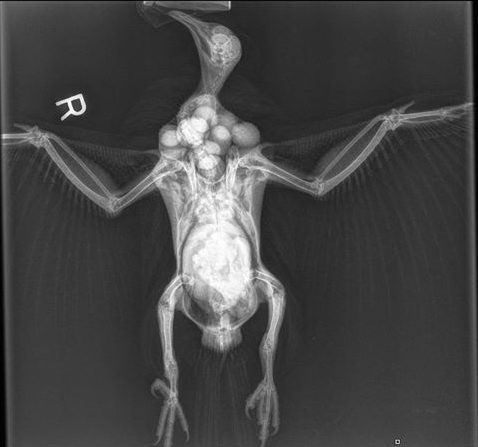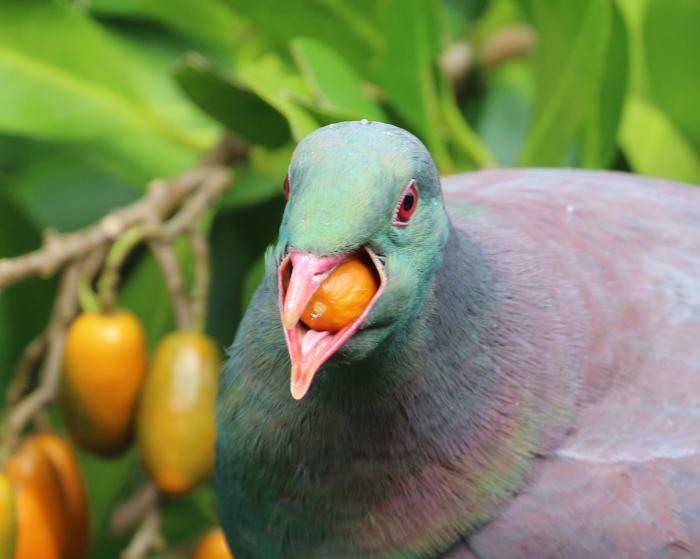Diet
Kererū eats the fruit, leaves, twigs, buds, and shoots of over a hundred native, and fifty exotic, shrubs and trees. Occasionally, they gorge so heavily on ripe fruit that they become very full (or “drunk”) and have been known to fall out of trees.
Kererū are very important to the survival of New Zealand forests because they’re the only birds left (all others are now extinct) big enough to swallow the large fruits of native trees such as taraire and karaka. After dining on fruit, they fly to a favourite roost to digest their meal. When they eventually pass that meal, they leave behind a dropping containing a seed and its very own package of fertiliser. This helps seedlings establish in new areas, and keep forests rejuvenated.
This role of propagator makes kererū a ‘keystone species’ of lowland forests.
Why are kererū important?

This x-ray of a kererū by the Avian Wildlife Rehabilitation Trust shows how many big berries it can fit in its crop!
Kererū spread the seeds of over 70 native forest plants, including kahikatea, rimu and nikau.
Now that birds like the huia and piopio are extinct, the kererū is the only native bird large enough to eat the big fruit of some of our important native forest trees like tawa, karaka, taraire, miro and puriri.
They also fly long distances – so are great at distributing seeds throughout the forest. After eating the fruits, the birds fly away and poo the seed somewhere else in the forest, along with some nutritious fertiliser!
If there were no kererū, there would be no bird to spread these seeds in the forest which would be a disaster for our native trees!
Essential for seed dispersal
The kererū has the widest gape of all New Zealand native birds, which allows it to eat large berries. This makes them vital to our forest ecosystem, as trees such as karaka, miro, tawa and taraire rely on them for seed dispersal. Kererū are one of New Zealand’s keystone species, essential for the ongoing propagationof some of our native plant species.
Some seeds need to pass through the gut of a bird to properly germinate. With the extinction of the moa, kererū are the only seed dispersers with a bill big enough to swallow large fruit.
They have been called our “gardeners of the sky” due to their unique ability to disperse these large seeds.
Feeding
Though the orange karaka berries are a major food source for kererū, the fresh kernels contain the alkaloid karakin, which is highly toxic to other animals. Dog owners have been warned to keep a close eye on their dogs to ensure they do not eat the berries, as this can be fatal. Our native species have evolved so that they can safely eat plants that others would find poisonous, for example, native bees are not harmed when they collect honeydew from tutu.
When fruit and flowers are not available, kererū will eat the leaves of trees such as kōwhai, tree lucerne, broom, willow, elm and poplar.
Occasionally, kererū gorge so heavily on ripe fruit that they become very full or drunk – as the fruit ferments inside them in the hot sun, they have been known to fall out of trees.



No comments:
Post a Comment